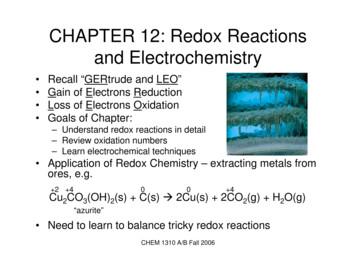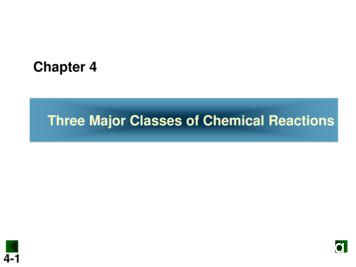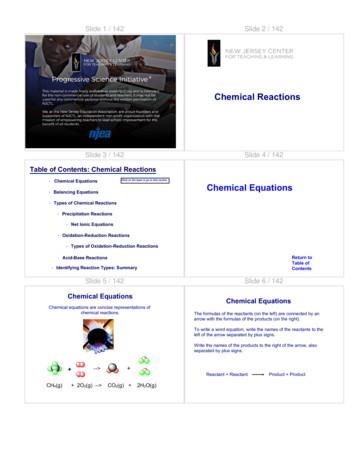Predicting Redox Reactions
Predicting Redox ReactionsA redox reaction may be explained as a transfer of electrons from one substance to another.Since two particles must be involved in an electron transfer, this transfer can be thought of as acompetition for electrons.Using a tug-of-war analogy, each particle pulls on the same electrons. If one particle is able topull electrons away from the other, a spontaneous reaction occurs. Otherwise, no reaction occurs.For example, when copper metal is placed in a solution of silver nitrate, a blue solution of coppernitrate is produced along with metallic silver.Cu ( s ) 2AgNO3 ( aq ) Cu ( NO3 )2 ( aq ) 2Ag ( s )In this reaction, the silver ion ( Ag ) pulls harder on copper’s electrons than copper does, thuswinning the tug-of-war. Copper loses electrons, becoming oxidized to form copper ions ( Cu 2 ),while the silver ions gain electrons, becoming reduced to form metallic silver ( Ag ).Unlike many other reactions that we have examined, this reaction is not reversible. If you placesilver metal in a solution of copper nitrate, no reaction will occur.Ag ( s ) Cu ( NO3 )2 ( aq ) no reactionBecause silver pulls harder on its electrons than the copper ions do, copper is unable to removeelectrons from the silver atoms. Thus, no reaction occurs.The above example described a single-replacement reaction. All reactions of this kind are redoxreactions. Chemical reactions for a great many single-replacement reactions can be written, butnot all of the reactions actually occur. The question that arises is, how can we predict whether ornot a given reaction will occur spontaneously?CH40SMr. Smith
Redox TablesA redox table consists of a series of balanced half-reactions, similar to the one shown below.Ag e Ag ( s )Each half-reaction can be read as a reduction by reading it from left to right, or as an oxidationby reading it from right to left. Thus, the entity on the left ( Ag in the above half-reaction) is theoxidizing agent, while the entity on the right ( Ag ) is the reducing agent.The half-reactions on a redox table are listed according to the relative strengths of the oxidizingand reducing agents, as illustrated by the sample table below.On the left side, the oxidizing agents are listed in order from weakest (at the top) to strongest (atthe bottom). On the right side, the reducing agents are listed in order from strongest (at the top)to weakest (at the bottom).The Spontaneity RuleThe image below illustrates how you can use a redox table to predict whether or not a reaction isspontaneous.A spontaneous redox reaction occurs only if the reducing agent (RA) is above the oxidizingagent (OA) on a table of relative strengths of oxidizing and reducing agents (redox table).CH40SMr. Smith
Example 1Will the following reaction occur? If so, complete the reaction.Cu ( s ) Mg 2 ( aq ) Example 2Predict whether or not a reaction will occur when tin strips are placed in hydrochloric acid.Redox tables are normally developed from experimental evidence. A series of reactions areattempted. For each attempt, it is recorded whether a reaction occurs or not. Once this evidenceis collected, it can be used to construct a redox table. The following example illustrates thisprocedure.Example 3The following reactions were performed. Construct a redox table from this information.3Co 2 ( aq ) 2In ( s ) 2In 3 ( aq ) 3Co ( s )Cu 2 ( aq ) Co ( s ) Co 2 ( aq ) Cu ( s )Cu 2 ( aq ) Pd ( s ) no reactionCH40SMr. Smith
CH40SMr. Smith
Worksheet1. The following reactions were performed. Construct a redox table.Co 2 ( aq ) Zn ( s ) Co ( s ) Zn 2 ( aq )Mg 2 ( aq ) Zn ( s ) no reaction2. In a school laboratory four metals were combined with each of four solutions. Construct aredox table.Be ( s ) Cd 2 ( aq ) Be 2 ( aq ) Cd ( s )Cd ( s ) 2H ( aq ) Cd 2 ( aq ) H 2 ( g)Ca 2 ( aq ) Be ( s ) no reactionCu ( s ) H ( aq ) no reaction3. Use the reactions below to construct a redox table.Ag ( s ) Br2 (l ) AgBr ( s )Ag ( s ) I 2 ( s ) no reactionCu 2 ( aq ) I ( aq ) no reactionBr2 (l ) Cl ( aq ) no reaction4. Arrange the following metal ions in order of decreasing strength as oxidizing agents: lead(II)ions, silver ions, zinc ions, and copper(II) ions.5. Use the spontaneity rule to predict whether the following mixtures will show evidence of areaction. Do not write the equation for the reaction.a) nickel metal in a solution of silver ionsb) zinc metal in a solution of aluminum ionsc) an aqueous mixture of copper(II) ions and iodide ionsd) chlorine gas bubbled into a bromide ion solutione) an aqueous mixture of copper(II) ions and tin(II) ionsf) copper metal in nitric acidCH40SMr. Smith
6. Prepare a redox table using the following experimentally obtained data. (R reaction, NR no reaction)AlTlGaInCH40SAl 3 NRNRNRNRTl RNRRRGa 3 RNRNRNRIn 3 RNRRNRMr. Smith
The above example described a single-replacement reaction. All reactions of this kind are redox . A series of reactions are attempted. For each attempt, it is recorded whether a reaction occurs or not. . Worksheet 1. The following reactions were performed. Construct a redox table.
ii. acid–base neutralization reactions iii. oxidation–reduction or redox reactions. Q.3. What are the important aspects of redox reactions? Ans: Almost every element participate in redox reactions. The important aspects of redox reactions are as follows: i. Large number of natural, biological and industrial processes involve redox reactions .
CHAPTER 12: Redox Reactions . Goals of Chapter: - Understand redox reactions in detail - Review oxidation numbers - Learn electrochemical techniques Application of Redox Chemistry - extracting metals from ores, e.g. Need to learn to balance tricky redox reactions Cu 2CO 3(OH) 2(s) C(s) Æ2Cu(s) 2CO 2(g) H 2O(g .
The Major Classes of Chemical Reactions. 4.6 Elements in Redox Reactions 4.1 The Role of Water as a Solvent 4.2 Writing Equations for Aqueous Ionic Reactions 4.3 Precipitation Reactions 4.4 Acid -Base Reactions. 4.5 Oxidation -Reduction (Redox) Reactions 4.7
Special Topic 6.1: Oxidizing Agents and Aging 6.2 Oxidation Numbers Internet: Balancing Redox Reactions 6.3 Types of Chemical Reactions Combination Reactions Decomposition Reactions Combustion Reactions Special Topic 6.2: Air Pollution and Catalytic Converters Single-Displacement Reactions Internet: Single-Displacement Reaction 6.4 Voltaic Cells
Scaffold : Redox Reactions Example Worksheet ATTENTION: This worksheet will be used to play the Redox relay and is modified into cards To determine if a reaction is a REDOX reaction: 1. Assign oxidation numbers to each element in the reaction. 2. If any of the oxidation numbers change in the reaction then the reaction is REDOX. Practice:
Chemical Reactions Slide 3 / 142 Table of Contents: Chemical Reactions · Balancing Equations Click on the topic to go to that section · Types of Chemical Reactions · Oxidation-Reduction Reactions · Chemical Equations · Net Ionic Equations · Types of Oxidation-Reduction Reactions · Acid-Base Reactions · Precipitation Reactions
Most of these reactions can be classified into one of three main types of chemical reactions: precipitation reactions, acid-base neutralization reactions, and oxidation-reduction (also called “redox”) reactions. Aqueous Solutions(aq) Many reactions occur in an aqueous environment (i.e.,
PASSOVER BLUEBERRY MUFFINS (Alexa & Riley Newbold) Ingredients: -1/3 cup butter -1 scant cup of sugar -3 eggs -1/2 teaspoon vanilla -1/2 cup matzo cake meal -1/4 cup potato starch -1/4 teaspoon salt -1 cup blueberries (frozen, drained)— don’t defrost -Cinnamon sugar . Directions: Cream sugar and butter. Add three eggs one at a time, beating after each. Add vanilla and mix. Add matzo cake .























